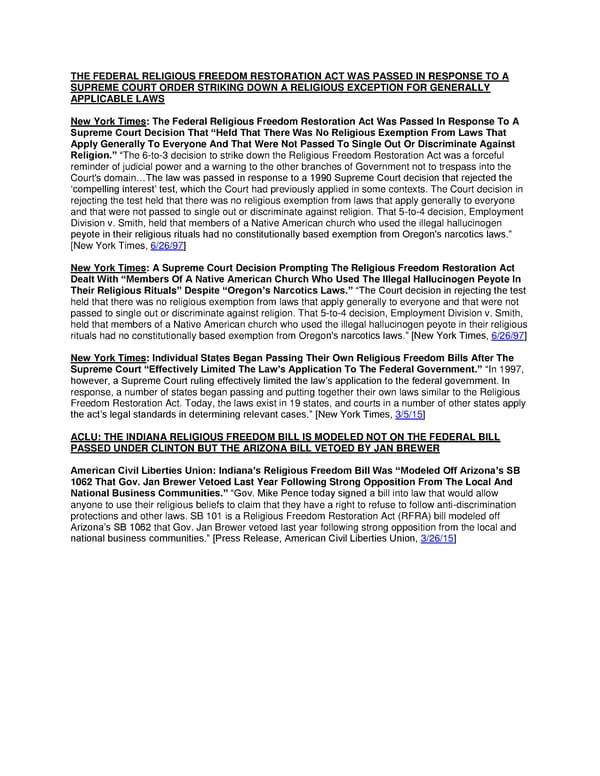Clinton RFRA
THE FEDERAL RELIGIOUS FREEDOM RESTORATION ACT WAS PASSED IN RESPONSE TO A SUPREME COURT ORDER STRIKING DOWN A RELIGIOUS EXCEPTION FOR GENERALLY APPLICABLE LAWS New York Times: The Federal Religious Freedom Restoration Act Was Passed In Response To A Supreme Court Decision That “Held That There Was No Religious Exemption From Laws That Apply Generally To Everyone And That Were Not Passed To Single Out Or Discriminate Against Religion.” “The 6-to-3 decision to strike down the Religious Freedom Restoration Act was a forceful reminder of judicial power and a warning to the other branches of Government not to trespass into the Court's domain…The law was passed in response to a 1990 Supreme Court decision that rejected the ‘compelling interest’ test, which the Court had previously applied in some contexts. The Court decision in rejecting the test held that there was no religious exemption from laws that apply generally to everyone and that were not passed to single out or discriminate against religion. That 5-to-4 decision, Employment Division v. Smith, held that members of a Native American church who used the illegal hallucinogen peyote in their religious rituals had no constitutionally based exemption from Oregon's narcotics laws.” [New York Times, 6/26/97] New York Times: A Supreme Court Decision Prompting The Religious Freedom Restoration Act Dealt With “Members Of A Native American Church Who Used The Illegal Hallucinogen Peyote In Their Religious Rituals” Despite “Oregon’s Narcotics Laws.” “The Court decision in rejecting the test held that there was no religious exemption from laws that apply generally to everyone and that were not passed to single out or discriminate against religion. That 5-to-4 decision, Employment Division v. Smith, held that members of a Native American church who used the illegal hallucinogen peyote in their religious rituals had no constitutionally based exemption from Oregon's narcotics laws.” [New York Times, 6/26/97] New York Times: Individual States Began Passing Their Own Religious Freedom Bills After The Supreme Court “Effectively Limited The Law’s Application To The Federal Government.” “In 1997, however, a Supreme Court ruling effectively limited the law’s application to the federal government. In response, a number of states began passing and putting together their own laws similar to the Religious Freedom Restoration Act. Today, the laws exist in 19 states, and courts in a number of other states apply the act’s legal standards in determining relevant cases.” [New York Times, 3/5/15] ACLU: THE INDIANA RELIGIOUS FREEDOM BILL IS MODELED NOT ON THE FEDERAL BILL PASSED UNDER CLINTON BUT THE ARIZONA BILL VETOED BY JAN BREWER American Civil Liberties Union: Indiana’s Religious Freedom Bill Was “Modeled Off Arizona’s SB 1062 That Gov. Jan Brewer Vetoed Last Year Following Strong Opposition From The Local And National Business Communities.” “Gov. Mike Pence today signed a bill into law that would allow anyone to use their religious beliefs to claim that they have a right to refuse to follow anti-discrimination protections and other laws. SB 101 is a Religious Freedom Restoration Act (RFRA) bill modeled off Arizona’s SB 1062 that Gov. Jan Brewer vetoed last year following strong opposition from the local and national business communities.” [Press Release, American Civil Liberties Union, 3/26/15]
 Clinton RFRA
Clinton RFRA